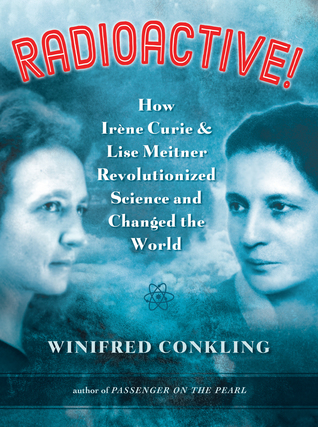 Conkling, Winifred. Radioactive!: How Irène Curie and Lise Meitner Revolutionized Science and Changed the World
Conkling, Winifred. Radioactive!: How Irène Curie and Lise Meitner Revolutionized Science and Changed the WorldJanuary 5th 2016 by Algonquin Young Readers
E ARC from Netgalley; paper copy from Baker and Taylor
Check out today's podcast for fiction books with science connections!
Marie Curie had a fascinating story that many younger readers have heard, but her daughter Irene's story is almost more fascinating because of the time during which she lived. Largely left to her own devices by her very driven scientist parents, Irene pursued similar academic interests, but also helped out with X-Rays at field hospitals during WWI, and at a very young age! Armed with both experience and knowledge, she worked in her parents' lab and went to college, where she excelled academically. She also met and married a fellow scientist, Frederic Joliot, and the two worked together and discovered artificial radiation. While the science was a bit hard for me to follow, the depiction of a woman struggling to be recognized in an academic science field in the early 1900s was fascinating.
We also learn about the slightly older Meitner, who also struggling not only to obtain an education, but to find jobs in her field. She worked with another scientist, Hahn, and actually took precautions against radiation poisoning in the labs where she worked, unlike the Curies! She was involved in experiments involving fission, but her work was interrupted by WWII. Feeling that her academic repute, as well as her Austrian passport, would protect her from Hitler's targeting of people of Jewish descent (which she was, although she felt Protestant), she did not leave Germany when there was an exodus of Jewish scientists. She was so stubborn about staying that she eventually had to be nearly kidnapped by friends in the scientific community and removed to Sweden! She continued to work, but was thwarted by lack of recognition and the generally difficult circumstances of moving to a new country at the age of 60.
While Curie and Meitner were often at odds scientifically, their experiences with trying to work in a field that was mainly the domain of men was very similar, and is an enlightening thing for teens to read about today. The book is filled with fascinating moments, and is an excellent choice for libraries where a lot of research is done. While I read nonfiction for fun, I don't have many middle school students who will sit down to 200+ pages of nonfiction. I wish I did, but I don't.
























Now this sounds interesting--and I never knew the Curies had daughters.
ReplyDeleteI loved reading about Madame Curie as a child, but did not know she had a daughter who made significant contributions. This sounds like a wonderful piece of nonfiction. Kudos to the author.
ReplyDeleteI have read several biographies about Curie, but this one could get me to read one more. :)
ReplyDeleteOoops, wasn't finished. One more about a Curie, that is. It sounds like this daughter had quite an interesting life. Since I'm at an elementary school, I have even fewer willing to read lengthy nonfiction works though Bomb circulates a little.
ReplyDeleteWow, this sounds fascinating. Thanks for the heads up.
ReplyDelete